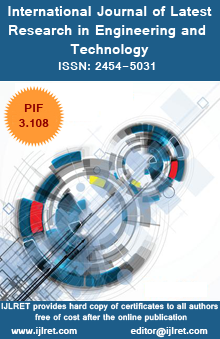Vol. 08, No. 10 [October 2022]
- Citation
- Abstract
- Reference
- PDF Download
| Paper Title | :: | Strategies to Overcome Barriers Women Face in the Construction Industry |
| Author Name | :: | Jennifer Warrner || Sarah Strong |
| Country | :: | United States of America |
| Page Number | :: | 01-04 |
There is a lack of women represented in the construction industry. In 2022, approximately 11% of the construction workforce was female. Though this percentage has increased over time, women working in construction are still working in a “man’s world.” The purpose of this study is to show what barriers women in construction face and how to overcome them. The information from this study can be a guide for future females pursuing a degree in construction management about how they can overcome barriers and attain success.
Key Words: barriers, construction industry, diversity, mentors, women
Key Words: barriers, construction industry, diversity, mentors, women
[1]. The National Association of Women in Construction. (n.d.). Statistics. NAWIC. Retrieved December 3, 2021, from https://www.nawic.org/nawic/Statistics.asp
[2]. Amaratunga, D., Haigh, R., Shanmugam, M., Lee, A. J., & Elvitigala, G. (2006). Construction industry and women: A review of the barriers. In Proceedings of the 3rd International SCRI Research Symposium.
[3]. Elvitigala, G., Amaratunga, D., & Haigh, R. (2006). The impact of culture on career development of women in construction. In Proceedings of 6th International Postgraduate Research Conference in the Built and Human Environment
[4]. Rosa, J. E., Hon, C. K. H., Xia, B., & Lamari, F. (2017). Challenges, success factors and strategies for women’s career development in the Australian construction industry. Construction Economics and Building, 17(3), 27-46.
[5]. Barreto. (2017). Barriers to the Professional Development of Qualified Women in the Peruvian Construction Industry. Journal of Professional Issues in Engineering Education and Practice, 143(4). 05017002.
[2]. Amaratunga, D., Haigh, R., Shanmugam, M., Lee, A. J., & Elvitigala, G. (2006). Construction industry and women: A review of the barriers. In Proceedings of the 3rd International SCRI Research Symposium.
[3]. Elvitigala, G., Amaratunga, D., & Haigh, R. (2006). The impact of culture on career development of women in construction. In Proceedings of 6th International Postgraduate Research Conference in the Built and Human Environment
[4]. Rosa, J. E., Hon, C. K. H., Xia, B., & Lamari, F. (2017). Challenges, success factors and strategies for women’s career development in the Australian construction industry. Construction Economics and Building, 17(3), 27-46.
[5]. Barreto. (2017). Barriers to the Professional Development of Qualified Women in the Peruvian Construction Industry. Journal of Professional Issues in Engineering Education and Practice, 143(4). 05017002.
- Citation
- Abstract
- Reference
- PDF Download
| Paper Title | :: | Sustainability thoughts 140: How can the consequences of the 2012 green market paradigm shift avoidance move that led to the world of dwarf green markets of today be highlighted, including the green Marxism threat? |
| Author Name | :: | Lucio Muñoz |
| Country | :: | Canada |
| Page Number | :: | 05-17 |
The Brundtl and commission in 1987 highlighted the need to address the social and environmental weaknesses of the traditional development model by moving away from traditional market thinking, which is based on the social and environmental externality neutrality assumptions. The United Nations Commission on Sustainable Development decided to prioritize the environmental issue recognizing that it was a real and binding issue so there was a need to move away from business as always by going the green market way, which was a move consistent with the academic consensus at that time, but in the end instead of going green markets global and local decision makers went the dwarf green markets way. In other words, instead of setting up environmental pollution reduction markets and promoting a new way of life under green consumers, green producers, green economics, green population dynamics, green culture and education, and so on to address the environmental pollution head on since 2012 and creating that way a path towards the environmentally clean economy, they decided to set up environmental pollution management markets. Environmentally pollution management markets are still profitable pollution production markets delinked from the transition to environmentally clean market paths. Which raises the question, how can the consequences of the 2012 green market paradigm shift avoidance move that led to the world of dwarf green markets of today be highlighted, including the green Marxism threat?
Key Words: Green market, green market paradigm shift, green market paradigm shift avoidance, dwarf green market, traditional market, environmentally dirty traditional market, environmentally clean market, clean market, dirty market, pollution reduction markets, environmental externality management markets.
Key Words: Green market, green market paradigm shift, green market paradigm shift avoidance, dwarf green market, traditional market, environmentally dirty traditional market, environmentally clean market, clean market, dirty market, pollution reduction markets, environmental externality management markets.
[1]. Muñoz, Lucio, 2022a. Sustainability thoughts 139: How can the 2012 road to transition from environmental pollution based traditional economies to the environmentally clean economies that the world never built be pointed out?, In: International Journal of Education Humanities and Social Science (IJEHSS), Vol. 5, No. 05, Pp. 65-77, ISSN: 2582-0745, India.
[2]. Muñoz, Lucio, 2022b. Sustainability thought 172: What is the structure of the general Thomas Kuhn’s paradigm evolution loop when the traditional market is a golden paradigm and when it is a flawed paradigm?, In: CEBEM-REDESMA Boletin, Año 16, Nº 9, September, La Paz, Bolivia.
[3]. Smith, Adam, 1776. The Wealth of Nations, W. Strahan and T. Cadell, London, UK.
[4]. United Nations Conference on Sustainable Development (UNCSD), 2012a. Rio+20 Concludes with Big Package of Commitments for Action and Agreement by World Leaders on Path for a Sustainable Future, Press Release, June 20-22, New York, NY, USA.
[5]. United Nations Conference on Sustainable Development (UNCSD), 2012b. The Future We Want, June 20-22, New York, NY, USA.
[2]. Muñoz, Lucio, 2022b. Sustainability thought 172: What is the structure of the general Thomas Kuhn’s paradigm evolution loop when the traditional market is a golden paradigm and when it is a flawed paradigm?, In: CEBEM-REDESMA Boletin, Año 16, Nº 9, September, La Paz, Bolivia.
[3]. Smith, Adam, 1776. The Wealth of Nations, W. Strahan and T. Cadell, London, UK.
[4]. United Nations Conference on Sustainable Development (UNCSD), 2012a. Rio+20 Concludes with Big Package of Commitments for Action and Agreement by World Leaders on Path for a Sustainable Future, Press Release, June 20-22, New York, NY, USA.
[5]. United Nations Conference on Sustainable Development (UNCSD), 2012b. The Future We Want, June 20-22, New York, NY, USA.
- Citation
- Abstract
- Reference
- PDF Download
| Paper Title | :: | Digital Grid Gems in Houdini Virtual Reality |
| Author Name | :: | Chaman Lal Sabharwal |
| Country | :: | USA |
| Page Number | :: | 18-25 |
The purpose of this paper is to show how Houdini Sidefx can be leveraged to develop “grid” gems. Here we start with a simple Houdini grid node and explore how this node can result in developing multifaceted scene views for virtual reality. With the advent of COVID-19, Virtual Reality has revolutionized academic world whether it is in-class teaching, online teaching, participating in the conferences in-person, or remotely, individual zoom meetings and all that. In addition, it led to innovation and development of new courses eBooks replacing printed books. Virtual reality was mainly in the realm of film and entertainment industry. It is changing the education culture altogether, and it is becoming the supporting pillar in every aspect of life. With this paper we show how immersion results in innovation of applications and how complex scenes can be created with a simple tool.
Key Words: virtual reality, user interface, animation, node
Key Words: virtual reality, user interface, animation, node
[1]. Yilmaz, B., &Goken, M. (2016). Virtual reality (VR) technologies in educatio of ı dustrialdesign , Global Journal on Humanites& Social Sciences. [Online]. 03, pp 498-503. Available from: http://sproc.org/ojs/index.php/pntsbs
[2]. Häf er P., Häf er V., O t haro a J., , Teaching methodology for Virtual Reality Practical Course in Engineering EducationProcedia Computer Science, 25, 251-260.
[3]. Xiaodong W., Dongdong W., Yue L., &Yogtia W., , Teaching based on augmented reality for a technical creative design course, Computers & Education, 81, 221-234.
[4]. Sherman W.R., & Craig A.B., (2003). Understanding virtual reality-interface, application and design. The United States of America: Morgan Kaufmann Publishers.
[5]. Weidlich D., Cser L., Polzin T., Cristiano D., & )i k er H., Virtual Reality Approaches for Immersive Design, CIRP Annals - Manufacturing Technology, 56(1),139-142.
[2]. Häf er P., Häf er V., O t haro a J., , Teaching methodology for Virtual Reality Practical Course in Engineering EducationProcedia Computer Science, 25, 251-260.
[3]. Xiaodong W., Dongdong W., Yue L., &Yogtia W., , Teaching based on augmented reality for a technical creative design course, Computers & Education, 81, 221-234.
[4]. Sherman W.R., & Craig A.B., (2003). Understanding virtual reality-interface, application and design. The United States of America: Morgan Kaufmann Publishers.
[5]. Weidlich D., Cser L., Polzin T., Cristiano D., & )i k er H., Virtual Reality Approaches for Immersive Design, CIRP Annals - Manufacturing Technology, 56(1),139-142.


